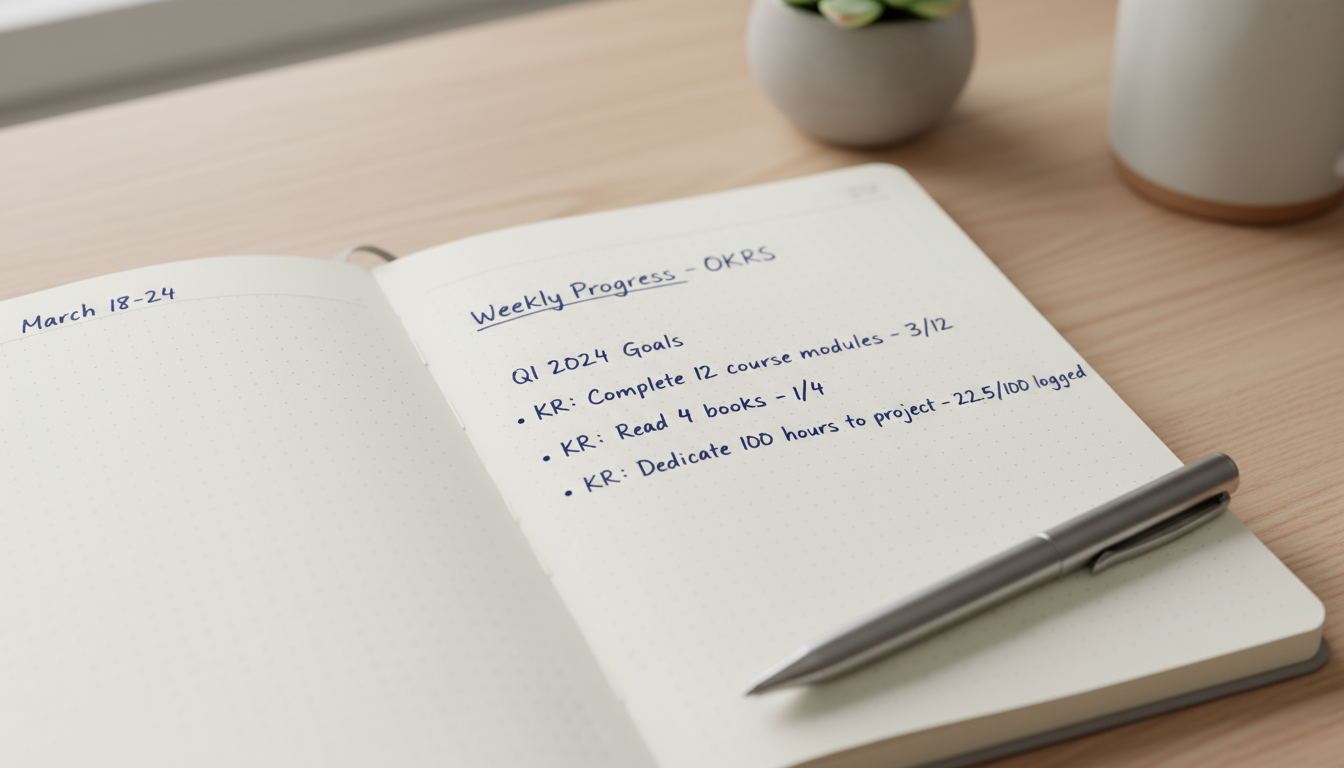
Welcome to TheFocusedMethod.com. As a goal-setting coach, I see the same pattern every single day. Someone arrives with a powerful desire to change their life—to launch a business, get in the best shape of their life, or learn a new language. They have the motivation and the vision. But their goals are vague, wishful statements like “get healthy” or “be more successful.” A month later, that initial spark of motivation has faded, and they’re right back where they started, feeling frustrated and stuck.
Why does this happen? It’s not a lack of willpower. It’s a lack of clarity and structure. Vague goals lead to vague actions, which produce no results. Without a clear target and a way to measure progress, it’s impossible to know if you’re on the right track. You end up drifting, reacting to daily urgencies instead of proactively building the life you want.
If this sounds familiar, I have good news. There is a system, born in the high-stakes world of Silicon Valley and used by companies like Google and Intel, that can bring radical focus and measurable progress to your personal life. It’s called the OKR method, which stands for Objectives and Key Results. This framework isn’t just for corporate giants; it’s a powerful tool for anyone who wants to turn ambitious dreams into reality. Forget fuzzy resolutions. This article will teach you how to set personal OKRs to create a clear roadmap, build unstoppable momentum, and finally achieve those personal goals you’ve been putting off for years.
We’ll go beyond the theory and give you a practical, step-by-step guide. You will learn how to translate a big vision into quarterly objectives, define key results that actually drive progress, and build a rhythm of review and adaptation that keeps you on track, even when life gets in the way. It’s time to stop wishing and start doing.
📚 Table of Contents
- What Exactly Are OKRs, and How Are They Different?
- The Focused Method: From Annual Vision to Daily Action
- Step 1: The Annual Vision (Your North Star)
- Step 2: Quarterly Themes (Your Objectives)
- Step 3: Measurable Milestones (Your Key Results)
- Step 4: Weekly Focus and Daily Actions
- Measurement and Cadence: The Rhythm of Progress
- Choose Simple Metrics and Tools
- The Weekly Check-In: Your Most Important Meeting
- How to Handle Slip-Ups and Setbacks
- Practical Planning: Making Time for Your Goals
- Time Blocking: Give Your Goals a Home on Your Calendar
- Establish Checkpoints and Celebrate Small Wins
- Constraint-Aware Planning
- Personal OKR Examples in Action
- Frequently Asked Questions About Personal OKRs
- 1. I have too many things I want to do. How do I choose just one or two objectives?
- 2. What if my personal or professional priorities conflict with each other?
- 3. My motivation is really low, even with a plan. What do I do?
- 4. My Key Result is hard to measure. How can I make it more concrete?
- Your First Three Steps to Goal-Setting Clarity

What Exactly Are OKRs, and How Are They Different?
You may have heard of other goal-setting frameworks, most notably SMART goals. SMART is an acronym that stands for Specific, Measurable, Achievable, Relevant, and Time-bound. It’s a fantastic foundation for making sure a goal isn’t just a daydream. For example, instead of “get fit,” a SMART goal would be “run a 5K race in under 30 minutes by June 1st.” It’s a huge improvement over a vague wish.
However, the OKR method takes this a step further by splitting your goal into two critical parts: the Objective and the Key Results.
The Objective (O) is the what. It is a significant, ambitious, and inspiring statement of what you want to achieve. It should be qualitative and memorable. It’s the destination you’re pointing your compass toward. It should make you feel a little excited and maybe even a little uncomfortable. An objective isn’t “run a 5K.” It’s “Achieve a new level of cardiovascular fitness and mental toughness.” See the difference? The latter provides a powerful “why.”
The Key Results (KRs) are the how. They are the measurable outcomes that prove you have reached your objective. If the Objective is the destination, the Key Results are the signposts along the way that tell you you’re getting closer. Each Objective typically has 2 to 5 Key Results. They must be quantitative, specific, and verifiable. There’s no gray area with a Key Result; you either did it, or you didn’t.
Let’s use our fitness example to illustrate:
Objective: Achieve a new level of cardiovascular fitness and mental toughness this quarter.
Key Results:
KR1: Run 5 kilometers without stopping by the end of the quarter.
KR2: Complete 3 running sessions per week, with zero missed weeks.
KR3: Decrease my average heart rate during a 1-mile run from 160 bpm to 145 bpm.
This structure gives you the best of both worlds: an inspiring, motivating vision (the Objective) paired with a concrete, data-driven plan for getting there (the Key Results). The magic of using the OKR method for personal goals lies in this combination of inspiration and execution.

Understanding Leading vs. Lagging Indicators in Your Key Results
To make your Key Results truly effective, it’s crucial to understand the difference between two types of metrics: lagging and leading indicators. A lagging indicator measures an outcome that has already happened. “Losing 10 pounds” is a classic lagging indicator. It tells you the result of your past actions, but you can’t directly control it today. You can’t just *decide* to lose a pound.
A leading indicator, on the other hand, measures the inputs and actions that you can control and that *predict* the future outcome. “Tracking my calories daily” or “completing 3 strength training workouts per week” are leading indicators. These are the levers you can pull every single day to influence the lagging indicator. Effective personal OKRs focus heavily on leading indicators for Key Results because they empower you to focus on your actions, not just the results. In our example above, “Complete 3 running sessions per week” is a powerful leading indicator.
This is also known as the difference between input goals and output goals. Your inputs are the effort you put in; the outputs are the results you get. While the ultimate output matters, your Key Results should be a healthy mix of both, with a strong emphasis on the inputs you have 100% control over. This simple shift is a game-changer for follow-through.

The Focused Method: From Annual Vision to Daily Action
A common failure point in goal setting is trying to connect a massive, distant dream to your Tuesday morning to-do list. It’s too big of a leap. The OKR method for personal goals provides a beautiful cascading structure that bridges this gap, creating a clear chain of command from your life’s vision down to your daily actions.
Think of it as a pyramid. At the top is your big-picture vision. At the bottom are the small, concrete tasks you perform every day. Here’s how to connect them.

Step 1: The Annual Vision (Your North Star)
Before you can set quarterly goals, you need a sense of direction. What does a successful year look like for you? You don’t need a perfect, 10-page plan. Just spend some time reflecting on the major areas of your life: career, health, finances, relationships, personal growth. What is one major, inspiring shift you want to make in one or two of these areas over the next 12 months? This is your high-level vision. It’s not an OKR itself; it’s the source from which your OKRs will flow.
For example, an annual vision might be: “Transition my career from marketing into a fulfilling role as a UX designer.” Or, “Build a strong foundation of physical health and energy that supports all other areas of my life.”

Step 2: Quarterly Themes (Your Objectives)
A year is too long to plan in detail. Life changes. A quarter (about 90 days) is the perfect timeframe for a focused sprint. Look at your annual vision and ask, “What is the most important thing I can accomplish in the next 90 days to move me significantly closer to that vision?”
This becomes your quarterly Objective. It should be ambitious and inspiring. Following our career transition example, a Q1 Objective might be: “Master the fundamentals of UX design and create a compelling portfolio piece.” This is a clear, focused theme for the next three months.
You should only have 1-3 high-level objectives per quarter. Any more than that and you’ll spread your focus too thin, accomplishing nothing. When learning how to set personal OKRs, the biggest mistake is setting too many. Focus is your superpower.

Step 3: Measurable Milestones (Your Key Results)
With your quarterly Objective set, it’s time to define how you’ll measure success. What are the 2-5 quantifiable results that will prove you’ve achieved your objective? These are your Key Results.
For the Objective “Master the fundamentals of UX design and create a compelling portfolio piece,” your KRs might be:
KR1: Complete all 12 modules of the ‘Google UX Design Certificate’ on Coursera.
KR2: Dedicate 100 hours to hands-on practice in Figma and Adobe XD, tracked in a timesheet.
KR3: Finish one end-to-end case study for a fictional mobile app, including user research, wireframes, and a high-fidelity prototype.
KR4: Receive feedback on the case study from 3 experienced UX professionals.
Notice how these are all measurable and verifiable. They are a mix of input goals (100 hours of practice) and output goals (complete a case study). They leave no room for doubt about whether you are making progress.

Step 4: Weekly Focus and Daily Actions
Your OKRs are your 90-day plan. They are not your daily to-do list. Each week, you’ll look at your Key Results and ask, “What are the most important actions I can take this week to make progress on my KRs?”
If KR2 is to dedicate 100 hours over the quarter, that breaks down to about 8 hours per week. So, your weekly plan would involve scheduling those 8 hours. If KR1 is to complete a course, your weekly plan might be “Complete Module 2 of the UX course” and “Watch 3 supplementary videos on user research.” These weekly goals are then broken down into daily tasks that go on your calendar or to-do list. This is how a grand vision becomes a tangible action you can take today.
![]()
Measurement and Cadence: The Rhythm of Progress
Setting your personal OKRs is the first step. The real magic happens in the consistent rhythm of execution and review. A plan that sits in a drawer is useless. The OKR method is a living system that requires your active participation.

Choose Simple Metrics and Tools
Don’t overcomplicate your tracking. A simple spreadsheet, a dedicated notebook, or a notes app is all you need. For each Key Result, you need to track your current status against your target. For example:
- KR: Complete 12 course modules. Tracking: 3/12 complete.
- KR: Dedicate 100 hours to practice. Tracking: 22.5/100 hours logged.
The goal is to be able to see, at a glance, exactly where you stand. This data is not there to judge you; it’s there to inform you. It transforms progress from a vague feeling into an objective fact, which is incredibly motivating.

The Weekly Check-In: Your Most Important Meeting
This is the cornerstone of making personal OKRs work. Every week, preferably at the same time (like Sunday evening or Monday morning), you must hold a 15-30 minute “meeting” with yourself. During this check-in, you do three things:
1. Score Your Progress: Update your tracking for each Key Result. A common practice is to score your confidence on a scale of 1-10. Are you on track (a 7 or 8)? Is it falling behind (a 3 or 4)? Be honest. This isn’t about perfection; it’s about awareness.
2. Reflect and Analyze: Look at the numbers. What went well this week? What obstacles did you encounter? If you’re behind on a KR, why? Was your weekly plan too ambitious? Did an unexpected life event derail you? Don’t beat yourself up. The goal is to learn what’s working and what isn’t.
3. Plan the Week Ahead: Based on your reflection, set 1-3 clear priorities for the upcoming week that will directly advance your Key Results. This connects your high-level quarterly plan to your immediate actions, ensuring you stay focused on what truly matters.

How to Handle Slip-Ups and Setbacks
You will have bad weeks. You will miss a workout. You will get busy with work and neglect your side project. This is not failure; it’s life. The difference between those who succeed and those who quit is how they handle these moments.
When you have an off-week, your weekly check-in is your safety net. It prompts you to acknowledge the slip-up without judgment. Instead of spiraling into “I’ve ruined everything,” you can look at the data and say, “Okay, I missed my target of 8 hours of practice and only did 2. Why? Because of that urgent work deadline. This coming week, that deadline is gone, so I can realistically schedule 8 hours. I’m still on track for the quarter if I get back to it now.”
The OKR framework is designed for ambition. In the corporate world, achieving 70% of a Key Result is often considered a success because it means the target was challenging enough. Give yourself the same grace. The goal isn’t 100% perfection. The goal is consistent, focused progress over time.

Practical Planning: Making Time for Your Goals
Having a brilliant set of personal OKRs is one thing; finding the time and energy to execute them is another. Your goals must have a home in your schedule, or they will always be pushed aside by the urgent but unimportant tasks of daily life. This is where practical planning techniques come into play.

Time Blocking: Give Your Goals a Home on Your Calendar
The single most effective way to ensure you work on your goals is to schedule them. Time blocking is the practice of dedicating specific blocks of time in your calendar to specific tasks. Instead of a to-do list that just floats in the ether, you are making a concrete appointment with your priorities.
At the beginning of each week, during your weekly check-in, look at the priorities you’ve set. Then, open your calendar and block out the time to do them. If one of your weekly goals is “Write 1,000 words for my book,” you might block out 7-8 AM on Tuesday and Thursday. If another is “Complete 3 running sessions,” you schedule them just like you would a doctor’s appointment. This act transforms a vague intention into a committed plan.

Establish Checkpoints and Celebrate Small Wins
A 90-day quarter can feel long. To maintain momentum, it’s helpful to set smaller, intermediate checkpoints. A mid-quarter review is a great idea. At the 6-week mark, do a slightly deeper review of your progress. Are your KRs still the right ones? Do you need to adjust your strategy? This prevents you from going too far down the wrong path.
Equally important is to celebrate progress. When you hit 50% of your practice hours KR, acknowledge it. When you complete that first portfolio piece, take a moment to appreciate the effort and the accomplishment. This isn’t frivolous; it’s a crucial part of the psychological process of goal achievement. As a coach, I’ve seen that positive reinforcement, even when self-administered, builds the resilience needed for long-term pursuits. You can find more on the power of reinforcement in resources from organizations like the American Psychological Association (https://www.apa.org).

Constraint-Aware Planning
One of the most practical pieces of advice I can offer is to be brutally realistic about your constraints. Your personal goals do not exist in a vacuum. You have a job, a family, social commitments, and a finite amount of energy. When you set your personal OKRs, you must do so with a full awareness of your life’s other demands.
If you have a demanding job and two young children, setting a Key Result of “Spend 20 hours a week learning to code” is setting yourself up for failure and burnout. A more realistic, constraint-aware KR might be “Spend 5 focused hours a week learning to code.” It might take you longer to reach the ultimate destination, but a sustainable pace will always beat an explosive start followed by a complete flameout. The best plan is the one you can actually stick to. Your OKRs should stretch you, but they shouldn’t break you.

Personal OKR Examples in Action
Theory is great, but seeing how the OKR method for personal goals works in practice makes it click. Let’s walk through two detailed, real-world scenarios in prose.

Example 1: The Career Pivot
Michael has been working in customer support for five years. He’s good at his job, but he feels stagnant and uninspired. After some soul-searching, he realizes he’s fascinated by data and how it can tell a story. His big-picture annual vision is to land an entry-level job as a Data Analyst. That’s his North Star.
For the first quarter, he knows he needs to build foundational skills. He doesn’t just say, “I’ll learn data analysis.” He creates a focused personal OKR. His Objective is: “Build a strong foundation in data analysis fundamentals and prove my new skills with a project.” This is inspiring and gives him a clear theme for the next 90 days.
Next, he defines his Key Results, the measurable proof of his success. After some research, he lands on these four:
KR1: Achieve a 90% or higher score on the ‘Data Analytics with Python’ course on DataCamp.
KR2: Complete 3 guided projects from the course, publishing the code to my new GitHub profile.
KR3: Clean, analyze, and visualize a public dataset (e.g., from Kaggle) and write a blog post explaining my findings.
KR4: Log 75 hours of dedicated study and practice time, tracked weekly.
Every Sunday night, Michael holds his weekly check-in. He updates his progress on a simple spreadsheet. In week 4, he notices his study hours are lagging. He’s only logged 18 of the 25 hours he should have by then. Instead of getting discouraged, he reflects. He realizes that trying to study after a long day at work isn’t effective. For the next week, he time-blocks 6-7 AM every weekday for his focused study. The following Sunday, he’s back on track. By the end of the quarter, he has completed the course, has three projects on GitHub, and his blog post about analyzing local real estate trends gets positive feedback online. He hasn’t landed a job yet, but he has made tangible, undeniable progress toward his annual vision.

Example 2: The Health and Wellness Goal
Jenna wants to improve her fitness. For years, her goal has been the vague “get in shape.” This year, she decides to try the OKR method. She knows that for her, “fitness” isn’t just about weight; it’s about feeling strong, energetic, and capable. Her annual vision is to build sustainable, healthy habits that she actually enjoys.
For her first quarter, she wants to focus on consistency and strength, not just cardio. Her Objective becomes: “Establish a consistent strength training routine and fuel my body properly.” This is motivating because it focuses on actions and feelings, not just a number on the scale.
She then sets her Key Results. She makes sure to focus on leading indicators—the actions she can control.
KR1: Complete 3 full-body strength workouts every week, with no more than one missed session in any two-week period.
KR2: Increase the weight I can squat for 5 reps from 45 pounds to 75 pounds.
KR3: Cook a pre-planned, protein-rich dinner at home on 5 out of 7 nights each week.
KR4: Get an average of 7 hours of sleep per night, tracked with my fitness watch.
Jenna tracks her workouts and meals in a journal. During a weekly check-in in the second month, she sees her sleep KR is consistently low, averaging around 6 hours. This lack of sleep is making her feel sluggish during workouts. This data gives her a clear problem to solve. She decides to implement a strict “no phone in the bedroom” rule and sets a reminder to start winding down at 10 PM. Her sleep average improves, and she finds she has more energy for her workouts. The progress on her squat (a lagging indicator) begins to accelerate. The system helped her identify the root cause of her plateau and fix it, something a vague goal of “get in shape” never could have done.

Frequently Asked Questions About Personal OKRs
As a coach, I hear the same questions time and again as people start implementing this powerful system. Here are answers to some of the most common challenges you might face when you begin to set personal OKRs.
1. I have too many things I want to do. How do I choose just one or two objectives?
This is the most common challenge, and it stems from a fear of missing out. The truth is, if you chase five rabbits, you will catch none. The power of OKRs comes from radical focus. To choose, use the “impact vs. effort” matrix. For each potential goal, ask yourself: 1) If I achieved this, what kind of positive impact would it have on my life? and 2) How much effort will it realistically take? Prioritize the goal that offers the highest positive impact for a manageable amount of effort for the next 90 days. You can always pursue another goal next quarter. A single, completed objective is infinitely more valuable than five half-finished ones.
2. What if my personal or professional priorities conflict with each other?
Life is not siloed. Your career, health, and family life all compete for the same 24 hours in a day. The key is integration and realism. First, acknowledge that you can’t go 100% on all fronts simultaneously. There will be seasons of intense focus on career, and other seasons where health or family must come first. When setting your quarterly OKRs, do a “whole life” check. If you know a massive project at work is launching this quarter, it is not the time to also set an objective to write a novel. Your personal OKR should complement or, at the very least, be able to coexist with your professional demands. Sometimes, the most important objective is to maintain balance, such as, “Create a sustainable work-life rhythm to reduce stress,” with KRs around leaving work on time or dedicating tech-free hours to family.
3. My motivation is really low, even with a plan. What do I do?
Motivation is a fickle feeling; you cannot rely on it. You must rely on systems and discipline. However, persistent low motivation can be a sign of a deeper issue with your OKR. Ask yourself these questions: Is my Objective truly inspiring to me, or is it something I feel I *should* do? Your “why” has to be powerful. Are my Key Results too daunting? If a KR feels impossible, you’ll be demotivated. Break it down into smaller, more achievable milestones. “Run a marathon” is terrifying. “Complete my first 3-mile run” is doable. Finally, make sure you are celebrating small wins. Progress itself is a powerful motivator. Acknowledge every step forward, no matter how small.
4. My Key Result is hard to measure. How can I make it more concrete?
This often happens with goals related to creativity or soft skills, like “be a better public speaker” or “become more creative.” The trick is to find a proxy—a measurable action or outcome that correlates with the quality you want to improve. For “be a better public speaker,” a KR could be: “Deliver 5 presentations to my team and solicit written feedback,” or “Record myself speaking for 10 minutes each week and identify one area for improvement.” For “become more creative,” a KR could be: “Fill 20 pages in my sketchbook this quarter,” or “Write 100 headlines for a fictional product.” You aren’t measuring “creativity” directly, but you are measuring the consistent actions that lead to its development.

Your First Three Steps to Goal-Setting Clarity
You’ve just learned about a powerful, structured approach to achieving your personal goals. The difference between reading about a method and actually using it is everything. Knowledge is potential, but action is power. The OKR method for personal goals isn’t a magic bullet, but it is a clear, reliable, and motivating framework that replaces vague hopes with a concrete plan of attack.
It forces you to define what success truly looks like. It compels you to focus on the actions you can control. And its rhythm of weekly check-ins provides the accountability and adaptability you need to navigate the messy reality of life. You don’t have to overhaul your entire life overnight. You just have to start.
Here are three simple decisions you can make today to get started:
1. Choose One Area of Your Life for Focus. Don’t try to set OKRs for your career, health, finances, and hobbies all at once. Pick the one area that, if improved, would have the biggest positive ripple effect on everything else. Is it your career? Your health? Your personal growth? Just pick one for the next 90 days.
2. Draft Your First Objective and Key Results. Get out a piece of paper or open a new document. Based on the one area you chose, write down an inspiring, qualitative Objective for the next 90 days. Then, brainstorm 2-4 measurable, quantifiable Key Results that would prove you’ve achieved it. Don’t worry about getting it perfect. Just get a first draft down. You can refine it later.
3. Schedule Your First Weekly Check-In. Open your calendar right now and book a recurring 30-minute appointment with yourself for the next 12 weeks. Title it “My Weekly OKR Review.” This is the most critical step. Committing to this rhythm of review and planning is what will turn your great intentions into tangible results.
At TheFocusedMethod.com, we believe that everyone has the capacity for incredible growth. What’s often missing is not the desire, but the framework. You now have that framework. Start small, stay consistent, and be kind to yourself along the way. Your future self will thank you for the focus you commit to today.
Disclaimer: The information provided in this article is for informational purposes only and is not intended as a substitute for professional medical, financial, or legal advice. Always seek the advice of a qualified professional with any questions you may have regarding a medical condition, financial situation, or legal matter.






